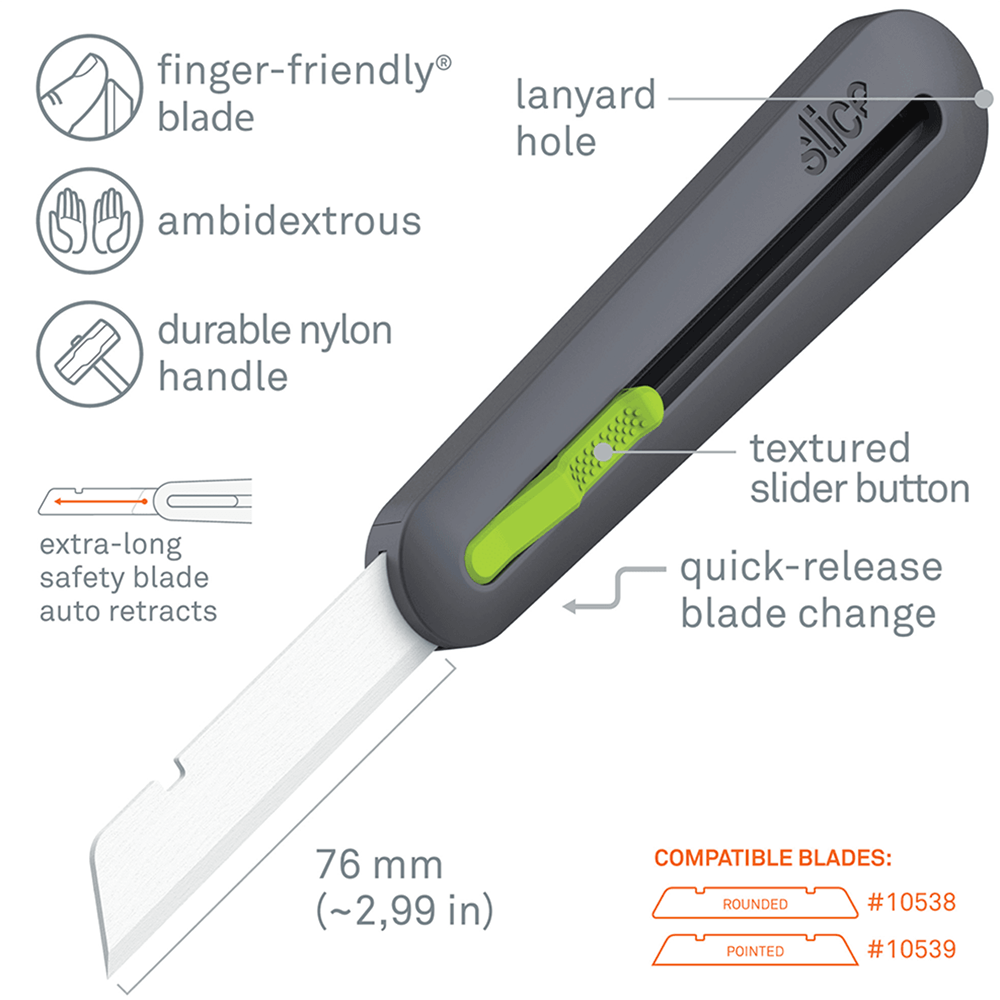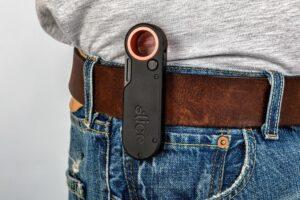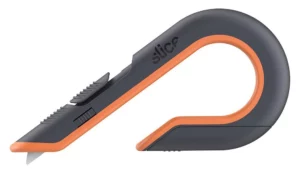
Construction Knives: Find Your Best Fit

Image shows one of Slice’s construction knives: the 10562 Folding Utility Knife clipped onto a worker’s belt.
Workers and home-owners alike use construction knives in all kinds of environmental conditions to cut a variety of materials. They rely on cutting tools to be as effective, sturdy, and safe as possible. But rather than grabbing the closest reasonably strong knife, it pays to learn a bit more about construction knives, including the benefits of different handle features, which knife style to choose for which material, and the features of different blades.
What is a Construction Knife?
A construction knife is defined not by its design, but by its use. In other words, any knife chosen to use in industrial or home construction can be considered a construction knife. This includes a:
- Razor blade
- Construction utility knife
- Pen knife
- Precision knife
- Construction pocket knife
- Box cutter
Depending on the situation, one knife might handle every job, or multiple specialty knives might make more sense. No matter what knife you choose, though, safety is not negotiable.
Safety in Construction Industries
Injuries are rampant in the construction field. Workers must lift, push, climb, and move in ways that push their bodies’ natural limits. They’re also expected to use equipment that can often be dangerous if it’s not operated correctly. This is true for both large machines, such as excavators, and hand tools, like construction knives. Because of this, Occupational Health and Safety (OHS) professionals rarely run out of construction safety topics to train their staff.
When it comes to evaluating knives for safety, many OHS pros rely on retractable knives to reduce blade exposure and therefore the chance for accidental cuts. While an automatic retraction mechanism can add some measure of safety to its overall design, the construction knife blade is where the biggest safety gains are made. After all, what cuts you: the handle or the blade?
Every Slice® construction knife uses finger-friendly® safety blades that effectively cutting your materials but are safe to the touch.
The Best Construction Knives for the Job
Utility knives are the all-stars of the construction world because they can handle the largest variety of jobs. Notice, in our breakdown below, how many applications construction utility knives can handle. But maybe variety isn’t what you’re looking for. If your niche in the construction industry is very specific, you might want a more specialized Slice tool. Scan below to find out which tool is right for you.
Plastic banding
Plastic banding surrounds materials on pallets, ensuring that packages stay together. A pointed-tip blade works better for this application. Watch the video below for a demonstration of the proper cutting technique.
Slice Tools We Recommend:
- 10550 Manual Utility Knife with 10528 (pointed-tip) blade
- 10554 Auto-Retractable Utility Knife with 10528 (pointed-tip) blade
- 10558 Smart-Retracting Utility Knife with 10528 (pointed-tip) blade
- 10512 Manual Pen Cutter with 10408 (pointed-tip) blade
- 10513 Auto-Retractable Pen Cutter with 10408 (pointed-tip) blade
- 10562 Folding Utility Knife with 10528 (pointed-tip) blade
- 10490 Manual Metal-Handle Utility Knife with 10525 (pointed-tip) blade
- 10491 Auto-Retractable Metal-Handle Utility Knife with 10525 (pointed-tip) blade
Modular Flooring
A pointed-tip blade initiates the cut cleanly in this rubberized product. Watch our demonstration below for tips.
Slice Tools We Recommend:
- 10550 Manual Utility Knife with 10528 (pointed-tip) blade
- 10554 Auto-Retractable Utility Knife with 10528 (pointed-tip) blade
- 10490 Manual Metal-Handle Utility Knife with 10525 (pointed-tip) blade
- 10491 Auto-Retractable Metal-Handle Utility Knife with 10525 (pointed-tip) blade
- 10562 Folding Utility Knife with 10528 (pointed-tip) blade
Drywall or Gypsum
Drywall is a difficult material to cut with any knife. We recommend using a pointed-tip blade and using the tool only for scoring, not cutting, your drywall.
Slice Tools We Recommend:
- 10550 Manual Utility Knife with 10528 (pointed-tip) blade
- 10554 Auto-Retractable Utility Knife with 10528 (pointed-tip) blade
- 10562 Folding Utility Knife with 10528 (pointed-tip) blade
Fiberglass Insulation
Both Slice industrial knives work well for anyone in the market for an insulation knife. These offer a cutting depth of up to three inches, and are compatible with optional pointed-tip or serrated blades. Fiberglass is notoriously rough on quick-dulling metal blades. Our finger-friendly industrial blades last up to 11 times longer than steel.
Slice Tools We Recommend:
- 10559 Manual Industrial Knife
- 10560 Auto-Retractable Industrial Knife
Single- and Double-Walled Cardboard
The Slice original box cutters are designed to handle single- and double-walled corrugated, which represents 98 percent of the corrugated on the market. The video below describes how to hold our box cutters for maximum effectiveness. Keep in mind that many other Slice tools work as box cutters, so if you’re looking for a more versatile tool, you might prefer one of our other options.
Slice Tools We Recommend:
- 10400 Manual Box Cutter with either 10404 (rounded tip) or 10408 (pointed tip) blade
- 10503 Auto-Retractable Box Cutter with either 10404 (rounded tip) or 10408 (pointed tip) blade
- 10512 Manual Pen Cutter with either 10404 (rounded tip) or 10408 (pointed tip) blade
- 10513 Auto-Retractable Pen Cutter with either 10404 (rounded tip) or 10408 (pointed tip) blade
- 10514 Mini Cutter with either 10404 (rounded tip) or 10408 (pointed tip) blade
- 10550 Manual Utility Knife with either 10526 (rounded tip) or 10528 (pointed tip) blade
- 10554 Auto-Retractable Utility Knife with either 10526 (rounded tip) or 10528 (pointed tip) blade
- 10558 Smart-Retracting Utility Knife with either 10526 (rounded tip) or 10528 (pointed tip) blade
- 10490 Manual Metal-Handle Utility Knife with either 10524 (rounded-tip) or 10525 (pointed-tip) blade
- 10491 Auto-Retractable Metal-Handle Utility Knife with either 10524 (rounded-tip) or 10525 (pointed-tip) blade
 Slice 10400 Manual Box Cutter is designed to cut single- and double-walled corrugated
Slice 10400 Manual Box Cutter is designed to cut single- and double-walled corrugated
Plastic Sheeting or Tyvek®
Handle shape is a factor here, depending on how you plan to cut your sheeting. Will in be on a flat surface? Vertical? Different positions? Choose your handle preference for maneuverability. Note that in all cases a pointed-tip blade is easier to use with plastic sheeting.
Slice Tools We Recommend:
- 10400 Manual Box Cutter with 10408 (pointed-tip) blade
- 10503 Auto-Retractable Box Cutter with 10408 (pointed-tip) blade
- 10512 Manual Pen Cutter with 10408 (pointed-tip) blade
- 10513 Auto-Retractable Pen Cutter with 10408 (pointed-tip) blade
- 10514 Mini Cutter with 10408 (pointed-tip) blade
- 10550 Manual Utility Knife with 10528 (pointed-tip) blade
- 10554 Auto-Retractable Utility Knife with 10528 (pointed-tip) blade
- 10558 Smart-Retracting Utility Knife with 10528 (pointed-tip) blade
- 10490 Manual Metal-Handle Utility Knife with 10525 (pointed-tip) blade
- 10491 Auto-Retractable Metal-Handle Utility Knife with 10525 (pointed-tip) blade
- 10562 Folding Utility Knife with 10528 (pointed-tip) blade
Stripping Insulation Off Wiring
This type of cut needs to be carefully depth controlled so that you cut only the outer insulation without damaging the interior wiring. The below video shows a customer demonstrating how he achieves this with the 10550 Manual Utility Knife.
Slice Tools We Recommend:
- 10550 Manual Utility Knife with either 10526 (rounded tip) or 10528 (pointed tip) blade
- 10490 Manual Metal-Handle Utility Knife with either 10524 (rounded-tip) or 10525 (pointed-tip) blade
- 10491 Auto-Retractable Metal-Handle Utility Knife with either 10524 (rounded-tip) or 10525 (pointed-tip) blade
Note that our metal-handle utility knives use our thinnest utility blades yet. Thinner blades reduce drag, making cuts through difficult materials easier.
 The Slice 3-Position Manual Utility Knife with ceramic safety blade.
The Slice 3-Position Manual Utility Knife with ceramic safety blade.
Rigid Foam Board
Your tool choice will depend on the depth of the foam board you’re cutting and the maneuverability you’ll need with the tool. In all cases, a pointed blade is preferred for this application.
Slice Tools We Recommend:
- 10400 Manual Box Cutter with 10408 (pointed-tip) blade
- 10503 Auto-Retractable Box Cutter with 10408 (pointed-tip) blade
- 10514 Mini Cutter with 10408 (pointed-tip) blade
- 10550 Manual Utility Knife with 10528 (pointed-tip) blade
- 10554 Auto-Retractable Utility Knife with 10528 (pointed-tip) blade
- 10558 Smart-Retracting Utility Knife with 10528 (pointed-tip) blade
- 10490 Manual Metal-Handle Utility Knife with 10525 (pointed-tip) blade
- 10491 Auto-Retractable Metal-Handle Utility Knife with 10525 (pointed-tip) blade
- 10562 Folding Utility Knife with 10528 (pointed-tip) blade
Dried Caulking
A pointed-tip blade is recommended for slicing dried caulking. Depending on the amount of caulking you’re cutting, you may prefer a manual handle style for ease, or an auto-retractable style for safety.
Slice Tools We Recommend:
- 10550 Manual Utility Knife with 10528 (pointed-tip) blade
- 10554 Auto-Retractable Utility Knife with 10528 (pointed-tip) blade
- 10512 Manual Pen Cutter with 10408 (pointed-tip) blade
- 10513 Auto-Retractable Pen Cutter with 10408 (pointed-tip) blade
Let us know how you use Slice construction knives or utility knives in the construction industry to reduce injuries and lower costs.
Further Information:
- Utility Knife: The Anatomy of an All-Purpose Tool
- Utility Knife Blades for Workplace Safety
- The Safety Blade: Everything You Need to Know

